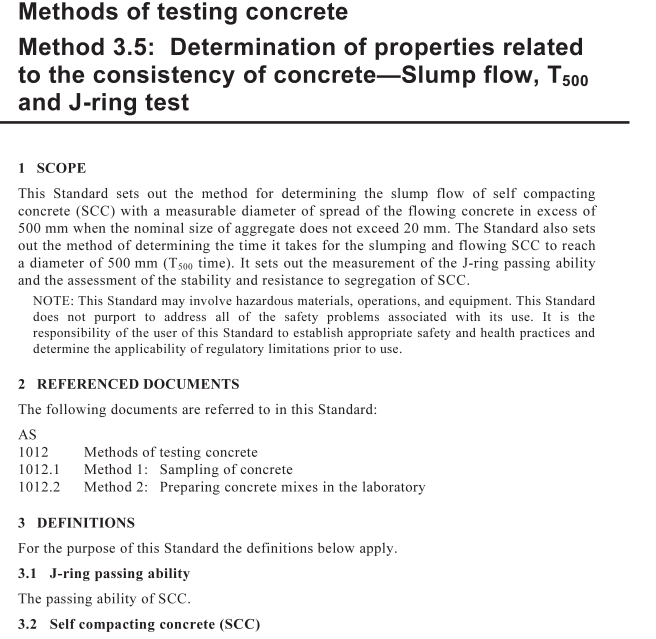AS 1012.3.5 pdf download – Methods of testing concrete Method 3.5: Determination of properties related to the consistency of concrete—Slump flow, T 500 and J-ring test

AS 1012.3.5 pdf download – Methods of testing concrete Method 3.5: Determination of properties related to the consistency of concrete—Slump flow, T 500 and J-ring test
5.7J-ring assembly
A ring assembly capable of rigidly fixing standard steel reinforcement vertical in a 300 mmdiameter circle, at standard intervals (see Figure 3). Standard steel reinforcement at least100 mm in length and spacing intervals based on the SCC ranking required, as follows:(a) Rank 1—18× 12 mm reinforcement at 40 +2 mm spacing.
(b) Rank 2—15× 12 mm reinforcement at 50 +2 mm spacing.(c)Rank 3—12×12 mm reinforcement at 66 12 mm spacing.
NOTE:The choice of sCC ranking required is influenced by the spacing of the steel bars and thedensity or congestion of the steel reinforcement in the concrete member.
5.8 Weighted collar
Weighted collar (optional),having a mass of at least 9 kg, to fit slump cone [sceFigure 3(b)].
NOTE:The weighted collar allows the test to be carried out by one person.5.9 Spirit level
Suitable to check that the base plate is level.5.10 Buckets and funnel (collar)
To obtain, remix and pour the concrete into the mould.6 SAMPLING
6.1Field sampling
For concrete sampled in the field, the test sample shall be obtained in accordance with therequirements of AS 1012.1.
6.2 Laboratory sampling
For concrete made in the laboratory, the test sample shall be prepared in accordance withAS 1012.2.
7 PROCEDURE
The procedure shall be as follows:
(a)For concrete sampled in the field and in the laboratory commence the test
immediately following the completion of mixing the test sample.
(b)Remix samples of concrete prior to testing by transferring from initial sub-sample
buckets into other buckets of equivalent size to ensure a homogenous sample.
(c) Ensure that the internal surface of the slump cone is clean and free from set concrete.(d)Moisten the internal surfaces of the sample bucket,funnel and slump cone and the
base plate by wiping with a damp cloth immediately before commencing each test.(e)lf required,place the specified J-ring assembly in the centre of the 200 mm diameter
circle marked on the base plate.
(f)
Place the slump cone carefully on a stable and levelled base plate, which is free fromvibration or shock.Hold the slump cone firmly in place.Position the slump cone withthe larger opening coincident with the 200 mm circle on the base plate (see Figure 2).Maintain the slump cone in position while it is being filled, ensuring that no concretecan leak from under the cone (see Figure 3).
(g)Ensure that the procedure from the start of filling to the removal of the slump cone
[i.e. Steps (h) to (l)],is carried out without interruption and is completed within anelapsed time of 2.5 min.
(h) Fill the slump cone by pouring in concrete continuously until it reaches the top edge
without vibration or tamping.Over-fill the slump cone slightly and if a detachableconical collar or funnel is used (see Note) then remove this.
NOTE: A detachable conical collar or funnel may be used to facilitate filling the slump cone.The collar or funnel should not penetrate the slump cone by more than 5 mm.
i)
Strike off the surface of the concrete level with the top of the slump cone by means ofa screeding and rolling motion of the rod so that the slump cone is filled exactly.Quickly remove any concrete overflow from around the base of the mould to precludeinterference with the movement of the flowing concrete and while doing so avoidingany movement or vibration of the slump cone.
(j)
Maintain a firm downward pressure at all times until the slump cone is removed.Immediately remove the slump cone from the concrete by raising it slowly andcarefully in a vertical direction,allowing the concrete to subside as it flowsconcentrically along the test surface.Complete the operation of raising the slumpcone in 3 ±l s in a steady vertical lift without causing any tilting, lateral or torsionalmovement of the slump cone and without interfering with the flow of the concrete.(k)
lf the Tsoo time (flow rate) is required,start the stopwatch immediately the slumpcone ceases to be in contact with the base plate and record the time to the nearest0.1 second,for the spreading concrete to reach the marked 500 mm (see Figure 2)circle at any point.
NOTE: It is possible for the stopwatch to be operated by the concrete tester or another personunder the concrete tester’s supervision.
Wait for the concrete to stop flowing and without disturbing the base plate orconcrete measure and record the largest diameter (d; ) of the resulting circular spreadof concrete to the nearest 5 mm. Measure and record a second diameter (dz) of thecircular spread at an angle approximately perpendicular to the first measured diameter(d), to the nearest 5 mm. [See Figure 4(a).]
lf the measurement of the two diameters differs by more than 50 mm,the test isinvalid and shall be repeated.
(m)When the J-ring passing ability is required, measure and record the height of concrete
at four locations just inside the J-ring bars and at four locations just outside andadjacent to the bars,the locations being at the 0,90,180 and 270 degree positionsaround the J-ring.[See Figure 4(b).] Record and report if blocking of aggregate hasoccurred.









